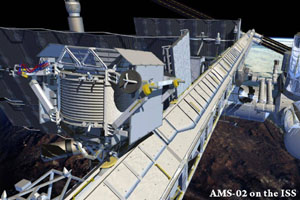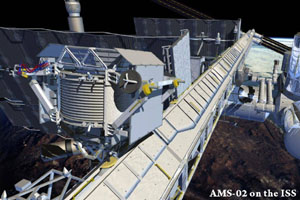 Artist concept of AMS-2 mounted on the ISS.When NASA's Space Shuttle Endeavour lifted off on its 25th and final mission to space on Monday morning, it carried in its cargo bay more than just supplies for the International Space Station. Alongside the containers of TV dinners, oxygen bottles, water tanks, and other various and sundry necessities was a bus-sized, two billion dollar observatory that will probe some of our Universe's deepest, darkest secrets: dark matter, and the unaccounted antimatter.
Artist concept of AMS-2 mounted on the ISS.When NASA's Space Shuttle Endeavour lifted off on its 25th and final mission to space on Monday morning, it carried in its cargo bay more than just supplies for the International Space Station. Alongside the containers of TV dinners, oxygen bottles, water tanks, and other various and sundry necessities was a bus-sized, two billion dollar observatory that will probe some of our Universe's deepest, darkest secrets: dark matter, and the unaccounted antimatter.
The Alpha Magnetic Spectrometer 2 (AMS-2), like other space-borne observatory satellites, will make its observations outside of Earth's atmosphere, attached to the International Space Station—but unlike "conventional" satellite observatories such as the Hubble Space Telescope, Kepler, and the Solar Dynamics Observatory, AMS-2 will not observe electromagnetic radiation (light), but rather cosmic rays.
Cosmic rays are energetic, electrically charged subatomic particles whizzing through space, originating from various places such as the Sun, distant stars and supernovae, and other high-energy sources from the most distant reaches of the known Universe. Most cosmic rays are simply high-speed protons (hydrogen nuclei) and alpha particles (helium nuclei). Less than 1% of cosmic rays are heavier atomic nuclei, and electrons. All of these particles are things familiar to us on Earth, the main differences being their exotic origins and their extremely high speeds—often approaching the speed of light.
A tiny fraction of cosmic rays are exotic particles indeed: antimatter, in the form of positrons (the positively charged antimatter counterpart of electrons) and anti-protons.
